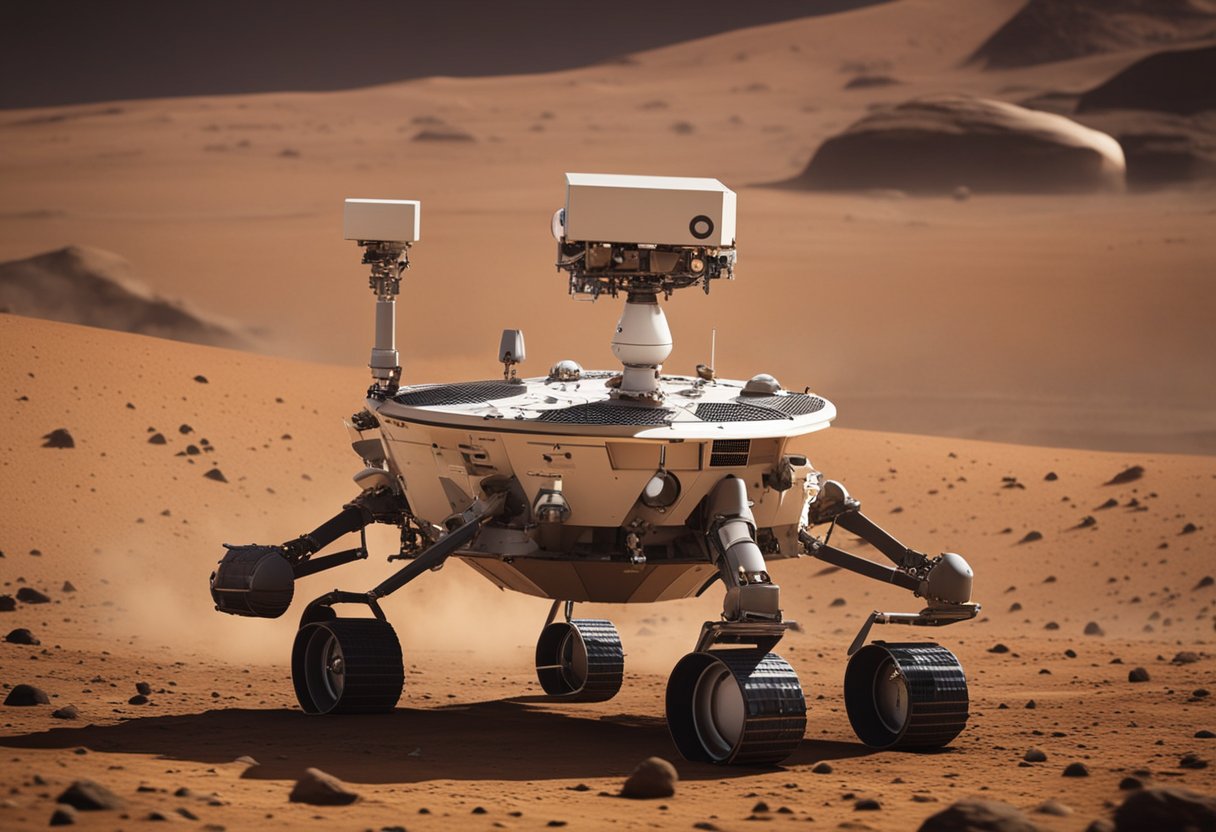
Mars Mission – As we look towards the heavens, the concept of sending humans to Mars stands as a beacon of our ambition and collective curiosity. The mission to Mars, once only a fixture of science fiction, is now within our scientific and technological reach. With the advancement of space travel, the idea of putting boots on the Red Planet offers numerous potential benefits, extending from scientific discovery to technological innovation. The collaborative nature of such missions employs a global skillset, fostering international cooperation and pushing each contributing nation towards a common goal.
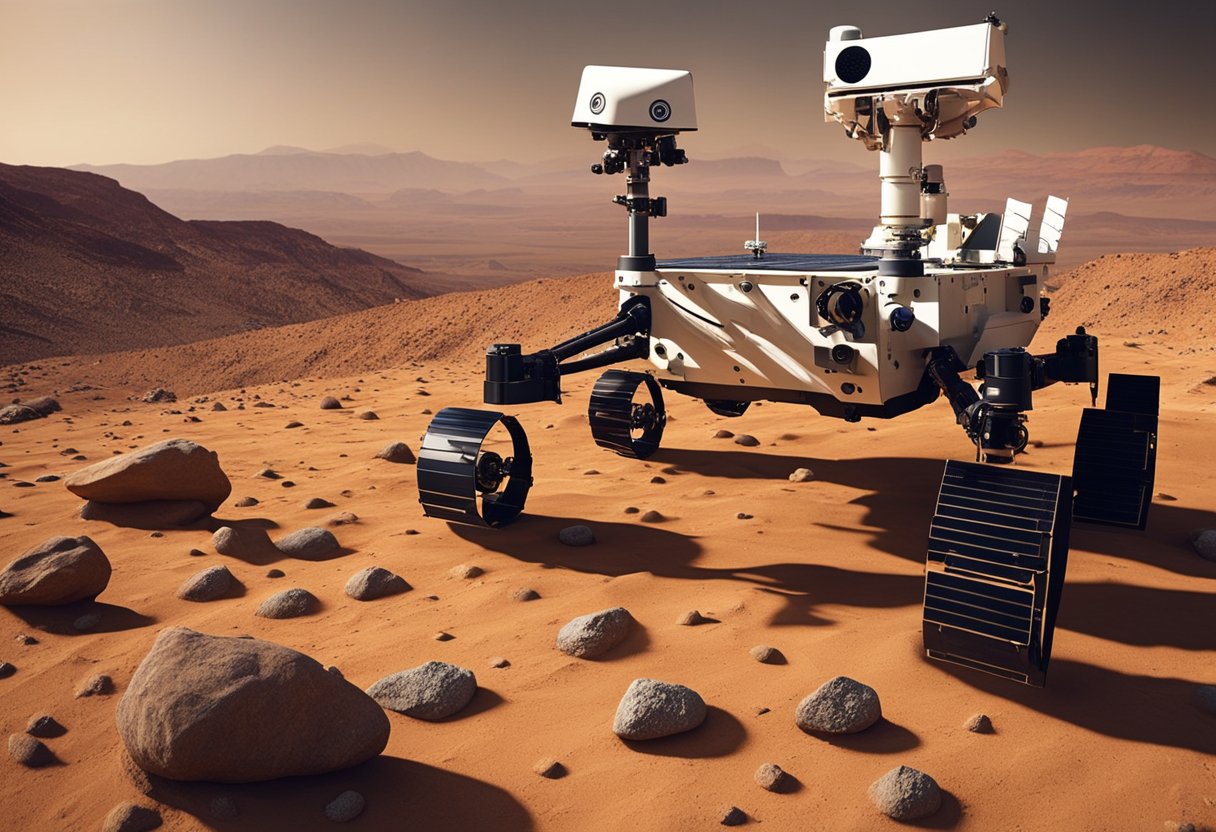
By establishing a human presence on Mars, we are not only engineering next-generation spacecraft and refining our abilities in resource management but also innovating new communication systems to manage data transmission across the vastness of space. Each breakthrough in technology during these missions paves the way for commercial and economic avenues back on Earth, as seen with the burgeoning field of space tourism highlighted by early ventures like SpaceVoyageVentures.com. Moreover, exploring Mars can act as a profound source of inspiration, capturing public interest and encouraging the next generation to dream big and embrace STEM fields.
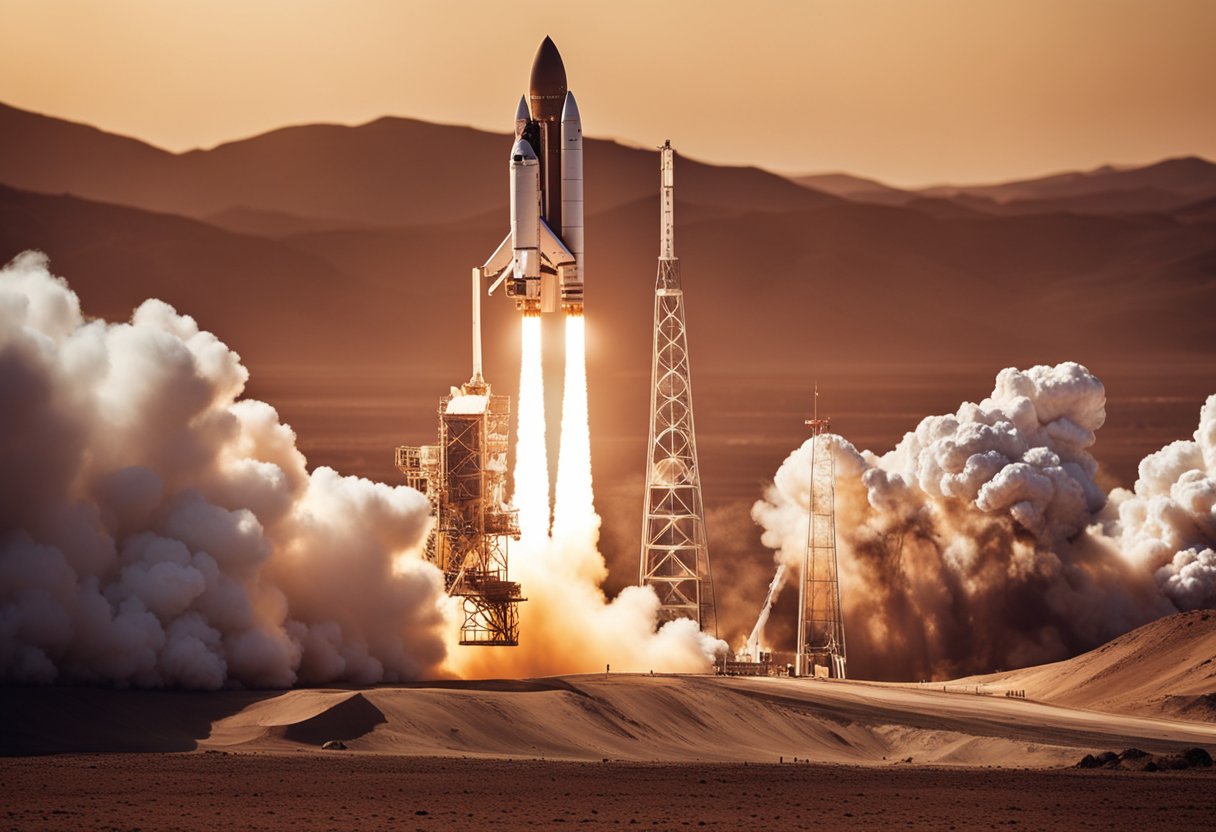
Our exploration of Mars has a storied history, marked by a series of technological triumphs and ambitious forays into the unknown.
Mariner 4 launched us into the Martian chronicle with its 1965 flyby, transmitting the first close-up images of the Martian surface. This monumental feat set the stage for what would become a relentless pursuit of knowledge. Fast-forwarding through time, Mars 3 took it a step further in 1971, achieving the first soft landing despite losing contact soon after. More sophisticated rovers followed, including Sojourner in 1997, heralding the era of mobile exploration.
Following these, the twin rovers Spirit and Opportunity made indelible marks on the Martian narrative, roving vast distances and outlasting their missions by years. Curiosity’s landing in 2012 then signalled a new age of exploration, equipped with a mobile laboratory to uncover the planet’s secrets, leading up to the most recent marvel, the Perseverance rover. These intrepid machines have made it possible for us to scrutinise the Martian climate and geology like never before.
Our journey has been dotted with noteworthy achievements. NASA’s Viking 1 mission deserves a special mention for placing the first U.S. lander on the Martian surface in 1976, followed by its twin, Viking 2. They delivered groundbreaking data on Martian soil and atmospheric composition. Not to be outdone, with India’s Mars Orbiter Mission successful insertion into Mars’ orbit in 2014, we became witness to a new era of interplanetary research led by various national space agencies.
The global collaborative efforts and technological innovations have seen us leap from observing Mars through telescopes to having sophisticated robots traverse its rugged terrain. Plans for manned missions continue to evolve, encapsulated by enthusiasm and speculation on websites like SpaceVoyageVentures.com, inviting us to consider the next giant leap for humankind.
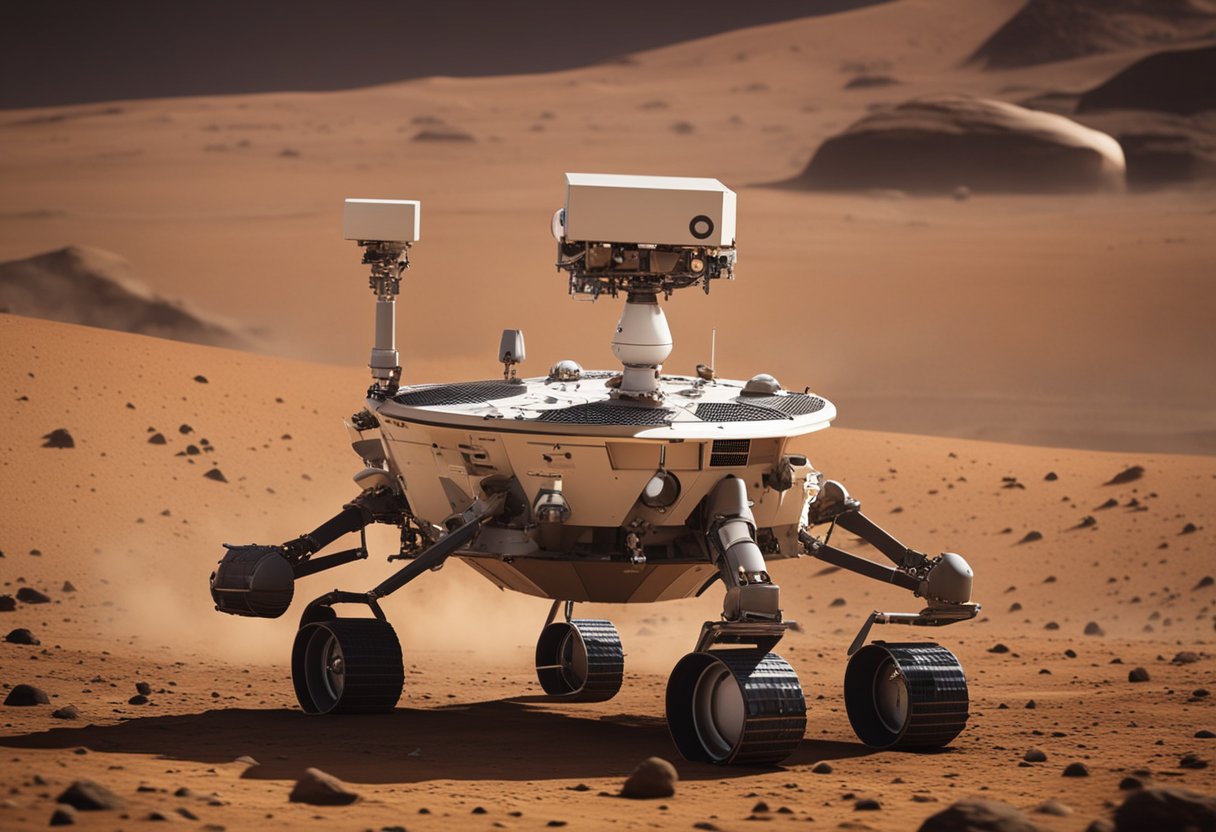
Mars missions have proliferated scientific knowledge, leading to notable advancements in our understanding of the Red Planet. These initiatives are shedding light on Mars’ geology and climate, and the potential for microbial life.
We’ve analysed Mars’ surface to decode its complex geological history. Scrutinising the Martian landscape, scientists have discovered features like river valleys and basins, indicating the planet’s wetter past. Investigations into the sediment in places such as Gale crater suggest that lakes once filled the landscape, potentially for millions of years. This informs us not only about Mars’ history, but also about broader planetary processes, including climate evolution. Studies of Martian atmosphere and gravity also guide us in developing technologies for future exploration and habitation.
Quests for microbial life drive much of our Martian exploration. Robots scouring the Martian terrain have identified methane spikes in the atmosphere, which may or may not be biological in origin. The northern hemisphere of Mars is of particular interest due to evidence suggesting it was once a large ocean, further fuelling our hypothesis of life beyond Earth. Sampling and analysing regolith and ice cores help us look for signs of bacteria or other organisms, potentially redefining our understanding of life’s resilience and distribution in the universe.
Through these focused efforts on the scientific front, Mars missions are expanding our horizons and could also ripple back health benefits on Earth, as research on radiation protection and remote medicine advances. Our pursuits on the Red Planet pave the way for not just scientific breakthroughs but also for prospective ventures like those documented on SpaceVoyageVentures.com, a site exploring the burgeoning realm of space tourism.
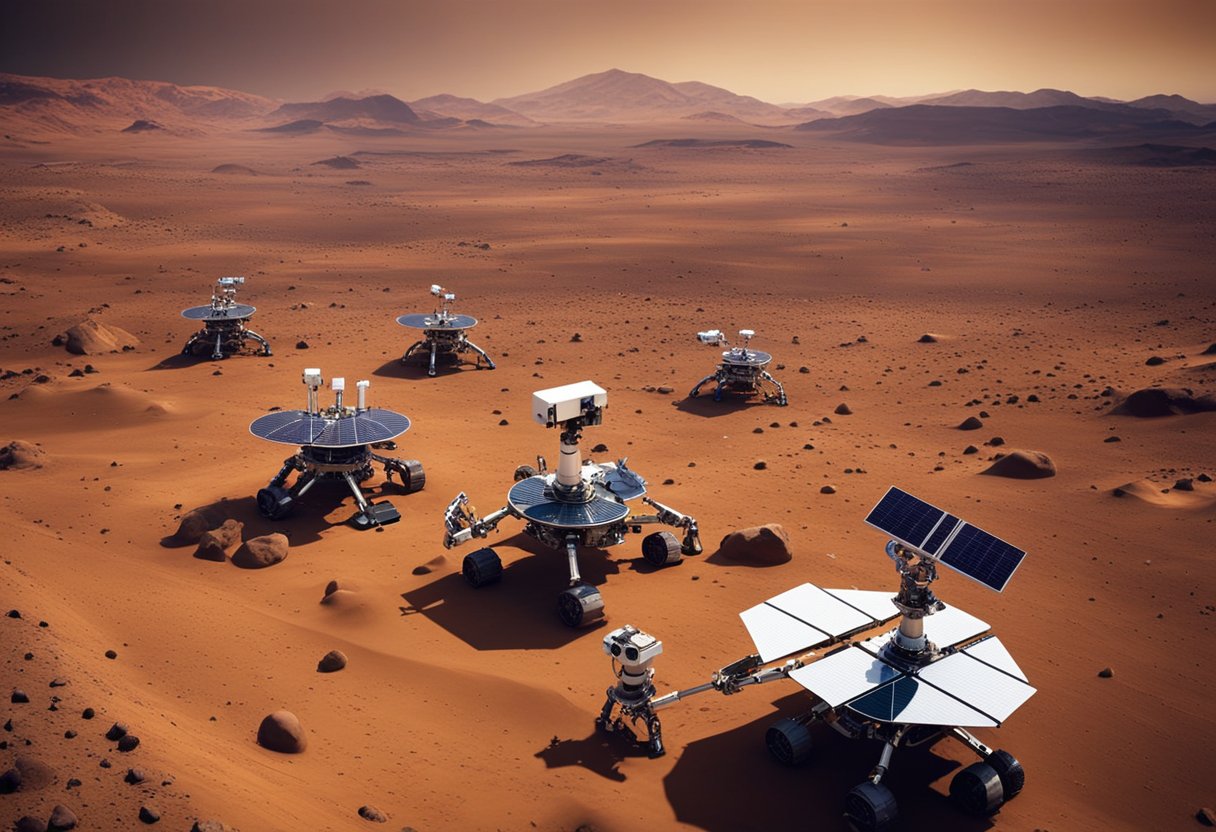
In our pursuit of sending humans to Mars, we’ve spurred a wave of technological innovations. These breakthroughs not only make the mission possible but also filter into other areas of science and technology, enriching multiple facets of society.
Our advancements in rover and lander technologies have been remarkable. These automated explorers are indispensable for gathering data and paving the way for human habitation. Notably, the implementation of the Range Trigger technology significantly improves landing accuracy by reducing the landing ellipse area. This precision enables rovers to arrive closer to their intended targets, which is crucial for the success of the mission and the efficient usage of resources.
Developing efficient propulsion systems and reliable life support mechanisms is essential. The Space Launch System (SLS), a powerful propulsion innovation, is designed to transport our astronauts and heavy payloads, providing a deep space capability we have not had before. Supporting the journey, cutting-edge life support systems are in development. A technique such as Methane Pyrolysis for oxygen recovery substantially decreases the mass needed for a mission. Our drive for sustainability continues with the potential use of nuclear fission power and solar electric propulsion, which could revolutionise energy use on spacecraft. These advancements underscore our dedication to safe, efficient, and sustainable space travel.
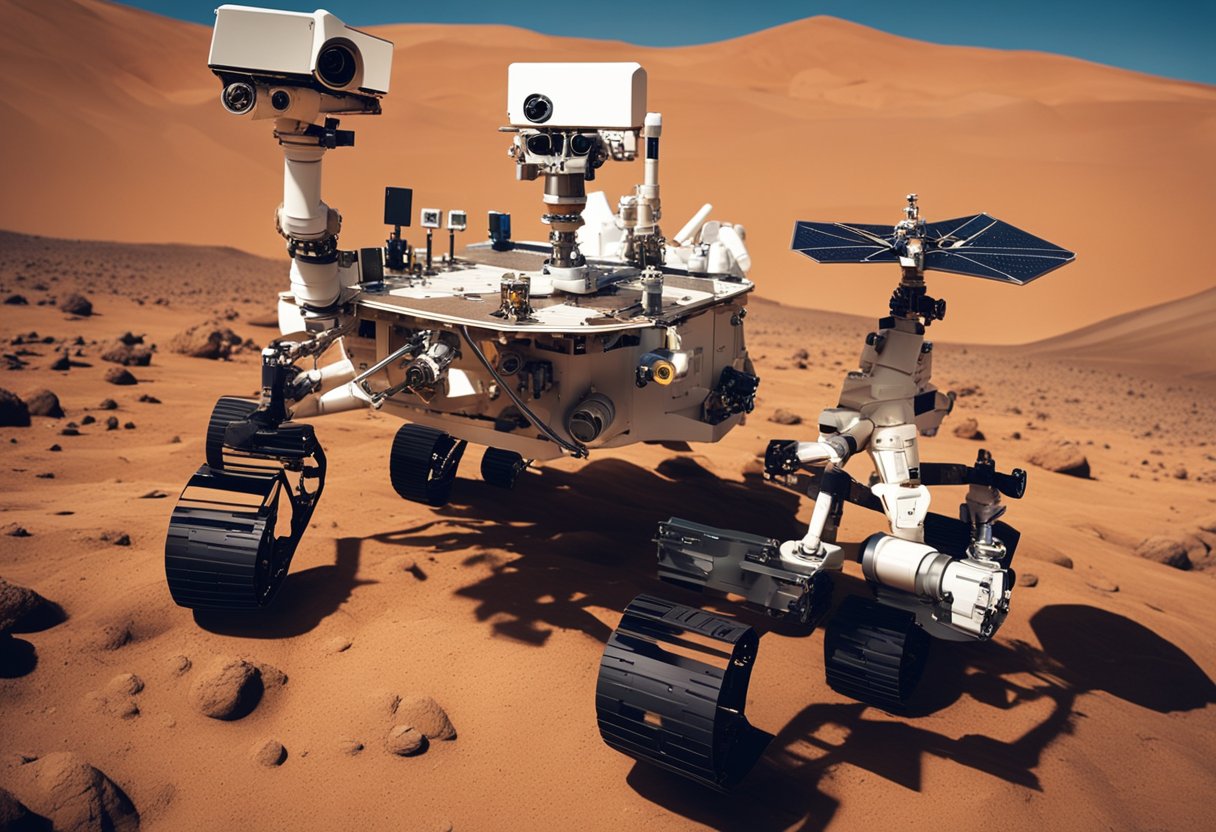
In manned missions to Mars, international collaboration plays a pivotal role in enhancing scientific research and maximising resource utilisation. Partnerships across countries and agencies bring diverse expertise and capabilities to the table, making the arduous journey more feasible and fruitful.
We recognise the immense value of partnerships and knowledge sharing in achieving a successful Mars mission. By pooling our resources and expertise, we amplify our collective scientific and technical knowledge. For instance, the Emirates Mars Mission (EMM) has captured the world’s attention by providing detailed images of Mars, showcasing how collaborations can lead to groundbreaking discoveries. The shared insights from this mission enrich our understanding of Mars’ atmosphere. Moreover, the assistance from NASA and other established space agencies to emerging space nations exemplifies the mutual benefits of such partnerships.
The reinforcement of relationships among the world’s space agencies is a compelling advantage of international collaboration. Joint projects, like the construction and utilisation of the International Space Station (ISS), have proven the potential of coordinated international efforts. Engaging multiple nations, including the United States and China, in the journey to Mars fosters a spirit of cooperation that not only propels space exploration but also promotes peace and unity on Earth. As these relationships continue to evolve, they lay a solid foundation for future space endeavours, including the possibility of ventures highlighted on SpaceVoyageVentures.com, which anticipates an era where space tourism intersects with conventional space missions.
Exploring the Martian surface through a manned mission to Mars has been a goal within our grasp. As we advance in our efforts to establish a human presence there, the potential for long-term habitability and the human adaptation to Martian conditions becomes increasingly significant.
Establishing a safe home for humans on Mars necessitates overcoming vast challenges, particularly in creating self-sustaining habitats that can support human life indefinitely. Key advancements include the development of life support systems capable of recycling water and air, and the ability to grow food on Martian soil. Projects like NASA’s In-Situ Resource Utilization (ISRU) are essential, as they convert local resources into water, oxygen, and fuel, reducing the need to launch supplies from Earth.
The presence of humans on Mars will also facilitate more complex scientific endeavours. For example, humans can perform sophisticated in-situ analysis of samples, which are crucial for astrobiology and the search for past or present life on Mars. We must, however, be cautious of the technological and ethical implications, understanding that our actions may permanently alter the Martian environment.
As we transition towards becoming a multi-planetary species, adapting to Martian conditions is a significant hurdle. The human body will face an environment with only about 38% of Earth’s gravity, leading to muscle deterioration and bone loss. Pioneering research into countermeasures is crucial; such research can both enhance our mission’s success and yield health benefits on Earth.
Martian dust storms, extreme temperature fluctuations, and high radiation levels present further challenges. Technologies developed to protect astronauts, ranging from advanced Martian habitats to space suits, can also have spin-off applications that can improve life on Earth.
Our journey to Mars goes beyond mere exploration—it builds our knowledge, technology, and resilience. Incorporating insights from space pioneers, our eyes are on the future, where companies like SpaceVoyageVentures.com are already forecasting the potential for space tourism, which includes future trips to Mars.
Through the collective efforts to make Mars a place where humans can live and work, we are paving the way for not just a manned mission to Mars, but a sustainable, long-term human presence on the Martian surface.
We recognise in our pursuit of interplanetary travel that the tasks we undertake in engineering and spacecraft design are both monumental and imperative. Our main focus is on creating robust systems that can withstand the challenges of space and support human life on such a long voyage.
Travelling the roughly 140 million miles to Mars presents engineering challenges unlike any we’ve faced before. Our engineers are committed to designing spacecraft that can operate for extended periods in the harsh conditions of space. Vehicles destined for Mars must be equipped with powerful propulsion systems, which are essential for reducing travel time and ensuring a safe journey to and from Mars. To maximise efficiency in orbit, systems such as the Range Trigger are developed to improve landing precision, significantly shrinking the targeted landing area, thus enhancing mission safety and success.
Additionally, such spacecraft must support all necessary life support systems, from food storage to waste management. To maintain physical health in low-gravity environments, we’ve had to innovate with space station technologies, bringing us invaluable data and insights. A current blend of engineering excellence and daring imagination continues to propel us towards our goal.
The spacesuits and habitats we are designing for Mars must function as personal space stations, providing life support in the form of air, food, water, and protection from the elements. Our spacesuits are being refined for increased mobility and durability, equipping astronauts to work effectively on the Martian surface. Innovations in spacesuit design by NASA are instrumental for safe extra-vehicular activities on Mars.
Regarding habitats, they must mimic conditions on Earth as much as possible, to support both mental and physical health. Innovations here are driven by ensuring that the basic needs of astronauts are met while considering the unique challenges of the Martian environment. Our habitats are designed to be rugged yet comfortable, ensuring a secure living space that can sustain human life for months or even years.
Engaging with websites like SpaceVoyageVentures.com, we keep abreast with the latest in space tourism, using insights from civilian space travel to inform the design of our Mars vehicles and habitats. Our shared experiences and knowledge are key to advancing human presence in space safely and sustainably.
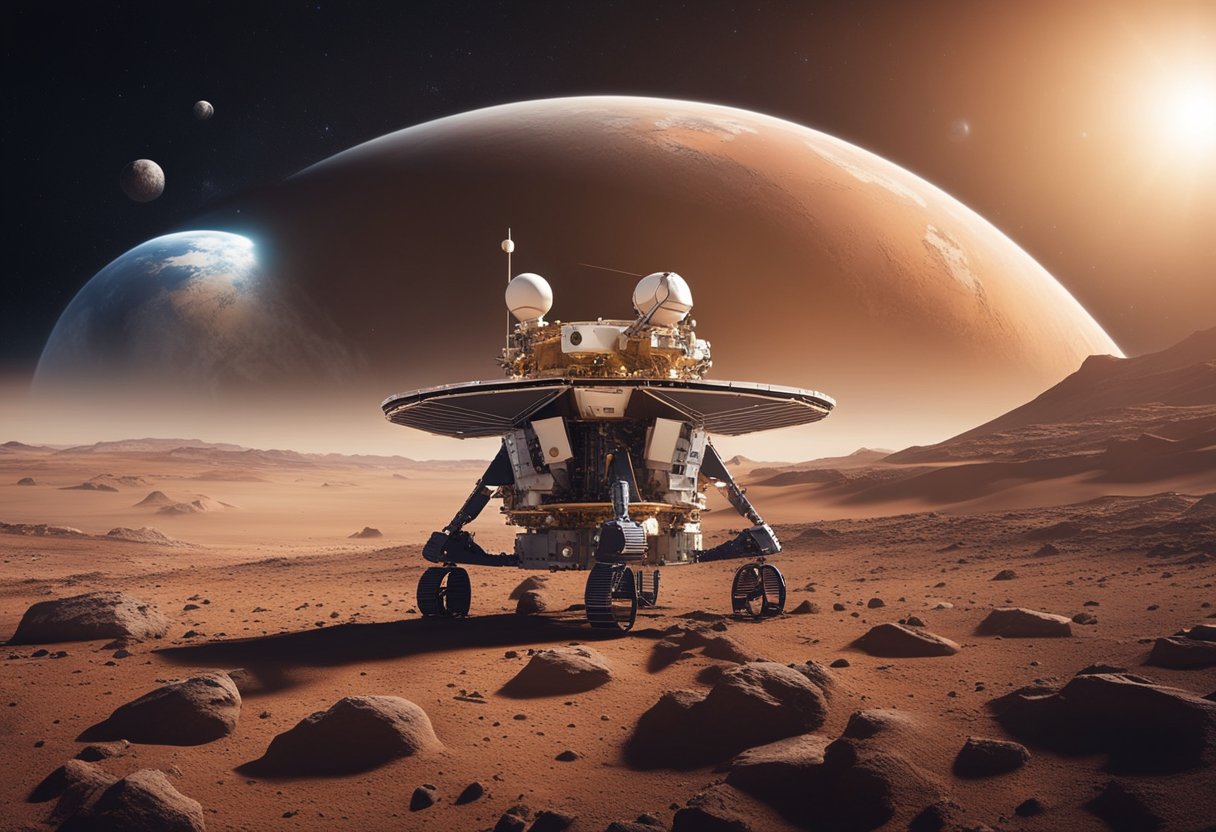
As we discuss the monumental task of launching manned missions to Mars, it is crucial to address how robust communication systems and efficient data transmission are fundamental to mission success.
To facilitate consistent and reliable communication with Earth during manned Mars missions, NASA is innovating in areas such as laser communications. This technology promises higher data rates than traditional radio frequency (RF) systems, allowing astronauts to send and receive information more quickly and clearly. We’re positioning ground stations around the Earth to ensure continuous contact with spacecraft, overcoming the planet’s rotation and other potential obstructions.
The use of satellites and orbiters plays a pivotal role in enabling long-distance Martian communications. Satellites orbiting Mars can act as relays, amplifying signals between Earth and astronaut teams on the Martian surface. This relay system also supports the transmission of high resolution video, as will be required on future missions. Satellites equipped with the latest technology will also help us manage the vast amount of scientific data collected, improving our understanding of Mars and the solar system.
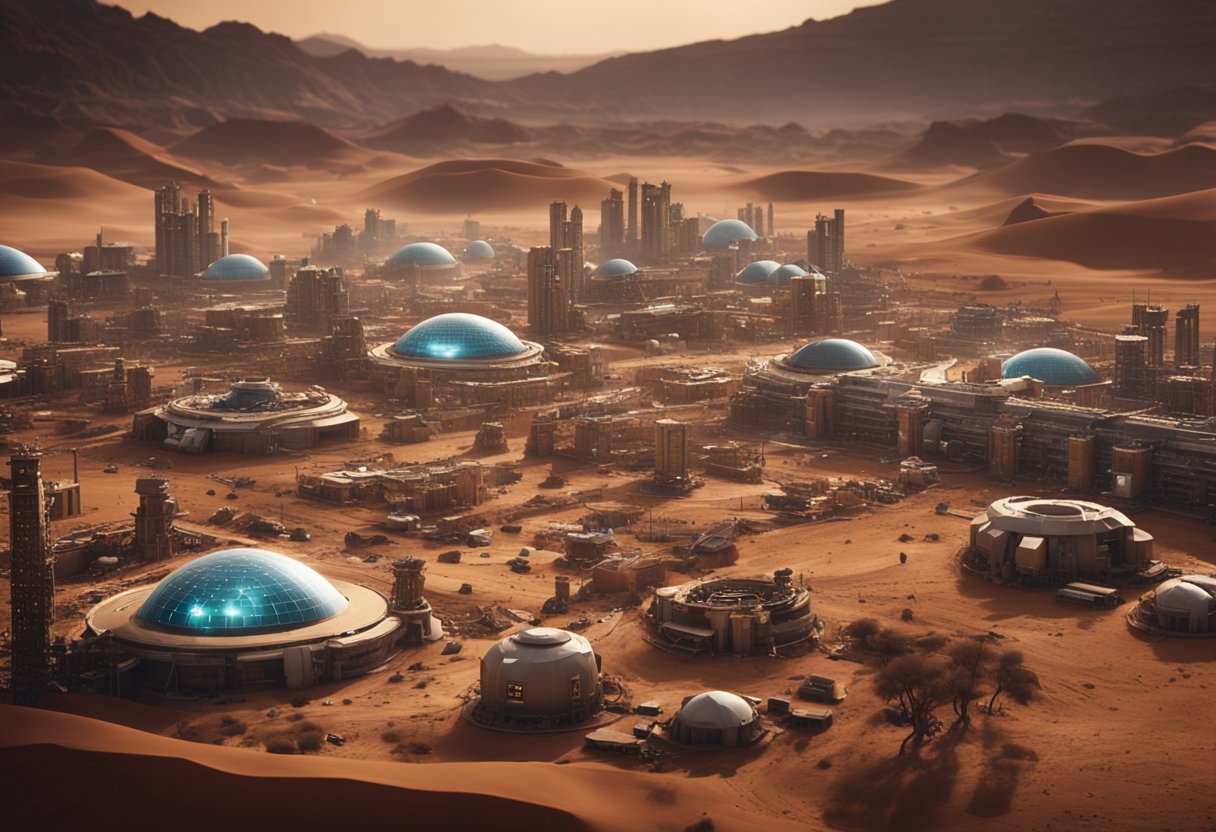
In exploring the prospects of manned missions to Mars, we must assess the intricate details of economic viability and the management of resources. This inquiry encompasses the careful planning of budget requirements and the strategic use of Martian materials.
The economic footprint of a manned Mars mission is substantial. Current estimates suggest a figure that could eclipse $100 billion over several decades. We scrutinise these figures with the hope of reducing costs via innovation and international partnerships. A part of this budget will be allocated to developing technologies that enable the extraction and utilisation of Martian resources, which could be pivotal in offsetting mission expenses. Mission budgets must also account for the development of sustainable solar power systems on Mars, to ensure energy demands of the colony and rovers can be met in an efficient manner.
In addition to importing resources from Earth, we envision utilising Mars’ natural resources through In-Situ Resource Utilisation (ISRU) strategies. This approach would see us converting Martian materials into useful commodities. The reality of these ventures is grounded in the ability to extract water for life support and oxygen production, and process regolith—the Martian soil—to construct habitats. With advancements in technology and economic investments, ISRU could revolutionise how we manage mission resources and could potentially open avenues for economic activities, like those proposed by SpaceVoyageVentures.com, where the utilisation of extraterrestrial materials might support future space tourism infrastructure.
Mars missions captivate our collective imagination, propelling both young and old toward the pursuit of knowledge and visions of future possibilities. These pioneering efforts foster an environment ripe for educational enrichment and cultural evolution.
Mars missions serve as a powerful catalyst for educational initiatives. They provide realistic contexts for teaching science, technology, engineering, and mathematics (STEM). Through hands-on projects and interactive space forums, students are inspired to pursue careers that contribute to space exploration. When schools organise skywatching events during major Mars missions, it brings academia and real-world science together, encouraging an on-going interest in space and related fields.
The intersection of actual space exploration and science fiction stimulates public interest in unprecedented ways. As we witness milestones like a manned Mars mission becoming tangible, the works of science fiction transform into a narrative of inspiration rather than mere fantasy. This cultural shift is evident in the way science fiction now interweaves with current events on platforms like SpaceVoyageVentures.com, which documents the burgeoning reality of space tourism intertwined with our hopes and dreams for interplanetary adventure.
The march toward human footsteps on Martian soil is advancing steadily with clear objectives. We’re looking towards the 2030s as a pivotal era for these monumental ventures.
For us, horizon goals signify a series of progressively complex missions that set the stage for sustained human presence on Mars and facilitate deeper solar system exploration. By the 2030s, we anticipate that our horizon goal to land humans on Mars will be within reach. These endeavours are crucial stepping stones, as we’ll gain invaluable insight into Martian geology, climate, and potential for past life. Future missions will incorporate lessons from these early explorations to ensure the safety and efficiency of subsequent long-term human habitations.
Beyond Mars itself, Phobos and Deimos present tantalising opportunities. Investigating these Martian moons may offer us essential resources and strategic advantages for further space exploration. Phobos, with its close orbit and low gravity well, could serve as an initial staging point for human exploration. Meanwhile, missions to Deimos and nearby asteroids might reveal important clues about the solar system’s history and possibly resources that could sustain future missions.
Our strategy remains firm: continue to build on the insights from each mission to ensure the success of our long-term interplanetary objectives. To follow these exciting developments and learn about potential future tourism opportunities, be sure to visit SpaceVoyageVentures.com.
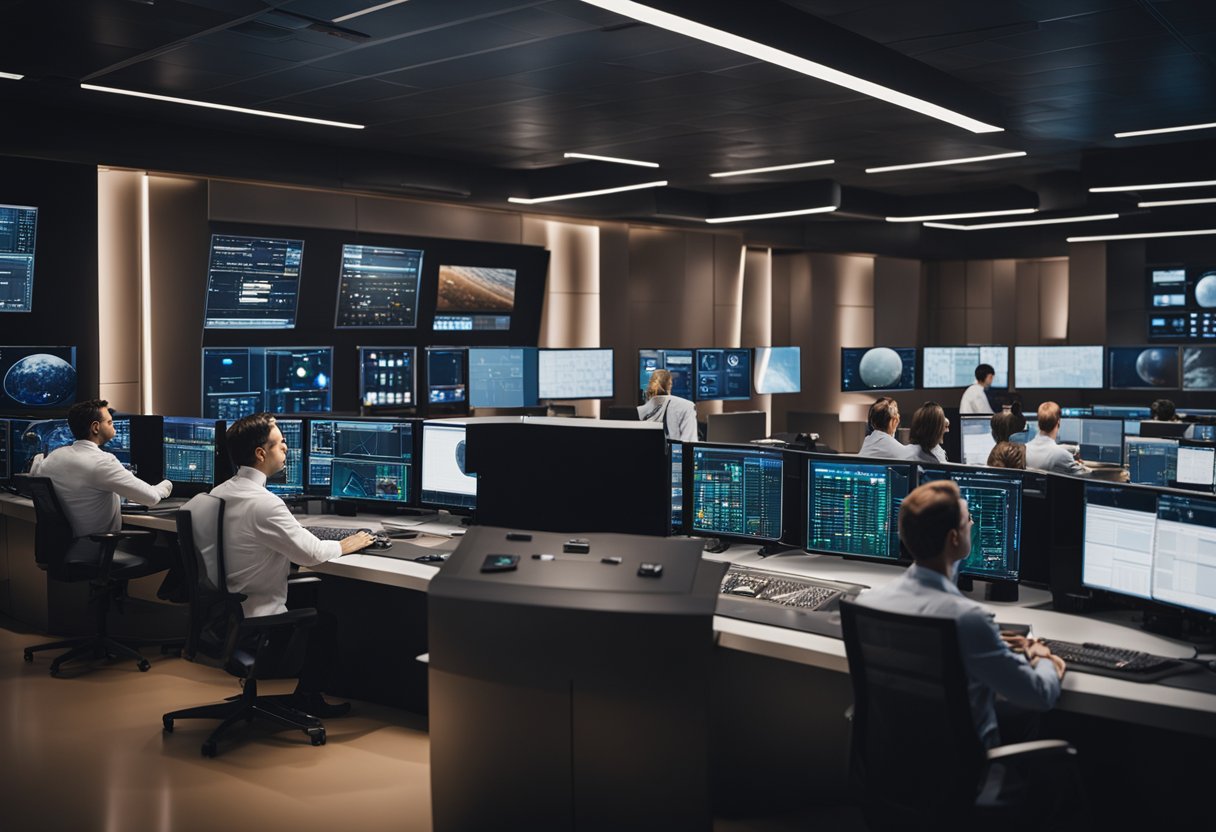
Exploring the red planet carries numerous implications for scientific advancement and interplanetary expansion. Here, we illuminate the questions many are pondering about the potential impacts of a manned mission to Mars.
Colonising Mars presents an unprecedented opportunity to safeguard our species against a planet-wide catastrophe by establishing a self-sufficient habitat on an entirely different planet. This would serve as a crucial step for human survival in the event of a disaster on Earth.
The benefits of exploring Mars extend to a better understanding of Earth’s history, climate, and geology through comparative analysis. Moreover, in situ resource utilisation could lead to advancements in mining and processing of Martian materials for construction and life support.
Sending astronauts to Mars is motivated by the pursuit of scientific knowledge, search for past or present life, and understanding Mars’ capacity to sustain future human life. It’s a quest that reflects our innate drive to explore, innovate, and push the boundaries of human experience.
A manned mission to Mars will yield a wealth of knowledge on human adaptability in long-term space travel, which is critical for future interstellar journeys. The technologies developed for such a mission could also find applications on Earth, such as in environmental control and life support systems.
Manned Mars missions could accelerate developments in fields like robotics, telemedicine, and closed-loop life support systems. These advances have the potential to improve life on Earth, particularly in remote areas where access to medical care and sustainable living practices are restricted.
There’s a growing consensus among experts that a manned mission to Mars could occur in the 2030s, recognising the formidable challenges that still need to be surmounted in terms of long-duration spaceflight, life support, and propulsion technologies.